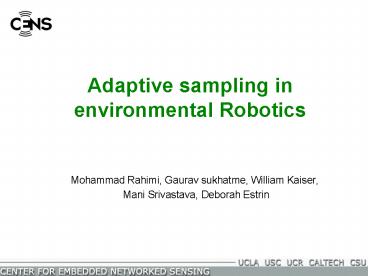Adaptive sampling in environmental Robotics - PowerPoint PPT Presentation
1 / 17
Title:
Adaptive sampling in environmental Robotics
Description:
The robot (shuttle) is an agent. gather Geostatistics information ... Shuttle is certain about the location. Sensor reading error is zero ... – PowerPoint PPT presentation
Number of Views:20
Avg rating:3.0/5.0
Title: Adaptive sampling in environmental Robotics
1
Adaptive sampling in environmental Robotics
- Mohammad Rahimi, Gaurav sukhatme, William Kaiser,
- Mani Srivastava, Deborah Estrin
2
Motivation
NIMS Networked Infomechanical Systems
3
47 m
Solar Cell
91
NIMS Node
84
Visible Imager With Pan/Tilt Actuator
Power Distribution Cable
50 m
Met Node (Ta, RH, PAR)
Battery Pack
Data Base
Telephone/ISP
Internet
WRCCRF Crane Site Dry Shack
4
Science Objectives
H2O
Q
C
C13/C12
T, RH, Wind
T, RH, Wind
C13/C12
T, RH, Wind
C13/C12
T, RH, Wind
Growth
Growth
5
NIMS Prototype Deployment
6
NIMS Prototype Deployment
7
Problem
- Creating a dynamic Map of the environment
- Based on the carrying sensors (attributes)
8
Approach
- The robot (shuttle) is an agent
- gather Geostatistics information
- Refresh those statistics as fast as possible
9
Digitizing robots world
0,0
Shuttle Patrol Area
Obstacles
Cell size that we call it a pixel is a xx.
pixel is the distance that shuttle moves
atomically
10
Assumptions
- Shuttle is certain about the location
- Sensor reading error is zero
- Environment is static in circuit convergence time
- Warning to the user to reduce coverage or
expected accuracy otherwise
11
Sampling Policy
- Stratified Sampling
- Divide the population into subpopulations
- Extremely better performance with some degree of
apriority domain knowledge - Random sampling
- Mean proportional to cell size
12
Feedback
- Using variance of data to classify a region
- Vaiance/Mean lt Expected error
- or
- Variance lt Sensor Noise
13
Divide and Conquer
- Stratify the current cell into four
- µ a cell size (µ is mean of step size)
- Collect data in current cells (Random)
- Calculate the variance
- Iterate until variance is below threshold
14
Closed Loop System
Acceptable error
Estimation
Stratification Policy
Map
Reading points
-
error
15
Result Of the Algorithm
- Quad-tree Map of the variance of the environment
- Shuttle step-size is random but proportional
- to how deep in the tree it is
n
Log (n)
n
16
Initial Results
17
Wish List
- Adding time domain
- Static sensors as sample support































